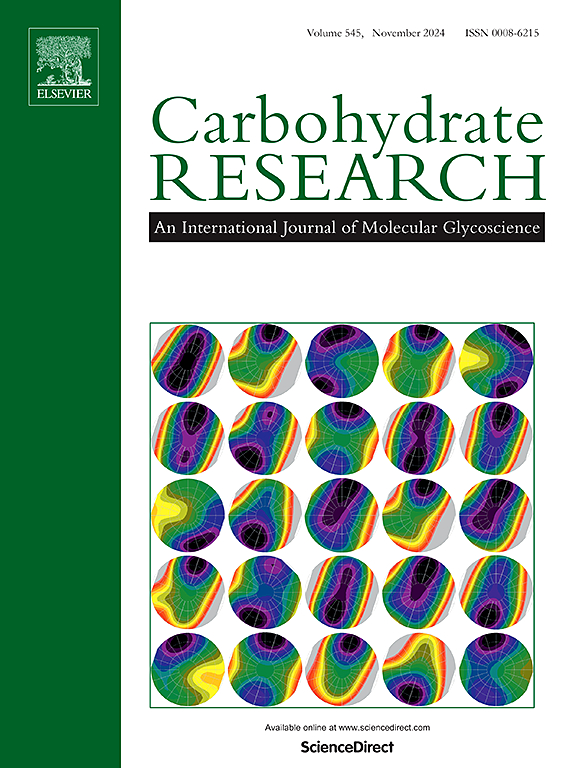真菌甘露聚糖中磷酸二酯链化学合成的最新进展
IF 2.4
3区 化学
Q3 BIOCHEMISTRY & MOLECULAR BIOLOGY
引用次数: 0
摘要
真菌甘露聚糖位于真菌细胞壁的外部,在这里它们与环境相互作用,并最终与人类宿主相互作用。甘露聚糖在形成针对真菌病原体的先天性免疫反应中发挥着重要作用。了解甘露聚糖酸性部分的磷酸二酯连接和甘露糖基重复单元对于理解其结构/活性关系以及开发抗真菌疫苗和免疫调节剂至关重要。磷酸二酯链连接着甘露聚糖聚合物的酸稳定部分和酸亲和部 分。磷酸基团连接在酸稳定部分甘露糖基重复单元的第 4 和/或第 6 位,以及酸易变部分甘露糖基重复单元的第 1 位。本综述重点介绍合成磷酸二酯链作为开发甘露聚糖仿糖剂的一种方法,这种仿糖剂以天然产品真菌甘露聚糖为基础。成功开发出磷酸二酯连接的合成策略,就有可能生产出针对现有和新出现的真菌病原体(如白色念珠菌和白色念珠菌)引起抗真菌免疫反应的甘露聚糖糖模拟物。本文章由计算机程序翻译,如有差异,请以英文原文为准。

Recent advances in chemical synthesis of phosphodiester linkages found in fungal mannans
Fungal mannans are located on the exterior of the fungal cell wall, where they interact with the environment and, ultimately, the human host. Mannans play a major role in shaping the innate immune response to fungal pathogens. Understanding the phosphodiester linkage and mannosyl repeat units in the acid-labile portion of mannans is crucial for comprehending their structure/activity relationships and for development of anti-fungal vaccines and immunomodulators. The phosphodiester linkages connect the acid-stable and acid-labile portions of the mannan polymer. Phosphate groups are attached to positions 4 and/or 6 of mannosyl repeat units in the acid-stable portion and to position 1 of mannosyl repeat units in the acid-labile portion. This review focuses on the synthesis of phosphodiester linkages as an approach to the development of mannan glycomimetics, which are based on natural product fungal mannans. Development of successful synthetic strategies for the phosphodiester linkages may enable the production of mannan glycomimetics that elicit anti-fungal immune responses against existing and emerging fungal pathogens, such as Candida albicans and Candida auris.
求助全文
通过发布文献求助,成功后即可免费获取论文全文。
去求助
来源期刊

Carbohydrate Research
化学-生化与分子生物学
CiteScore
5.00
自引率
3.20%
发文量
183
审稿时长
3.6 weeks
期刊介绍:
Carbohydrate Research publishes reports of original research in the following areas of carbohydrate science: action of enzymes, analytical chemistry, biochemistry (biosynthesis, degradation, structural and functional biochemistry, conformation, molecular recognition, enzyme mechanisms, carbohydrate-processing enzymes, including glycosidases and glycosyltransferases), chemical synthesis, isolation of natural products, physicochemical studies, reactions and their mechanisms, the study of structures and stereochemistry, and technological aspects.
Papers on polysaccharides should have a "molecular" component; that is a paper on new or modified polysaccharides should include structural information and characterization in addition to the usual studies of rheological properties and the like. A paper on a new, naturally occurring polysaccharide should include structural information, defining monosaccharide components and linkage sequence.
Papers devoted wholly or partly to X-ray crystallographic studies, or to computational aspects (molecular mechanics or molecular orbital calculations, simulations via molecular dynamics), will be considered if they meet certain criteria. For computational papers the requirements are that the methods used be specified in sufficient detail to permit replication of the results, and that the conclusions be shown to have relevance to experimental observations - the authors'' own data or data from the literature. Specific directions for the presentation of X-ray data are given below under Results and "discussion".
 求助内容:
求助内容: 应助结果提醒方式:
应助结果提醒方式:


